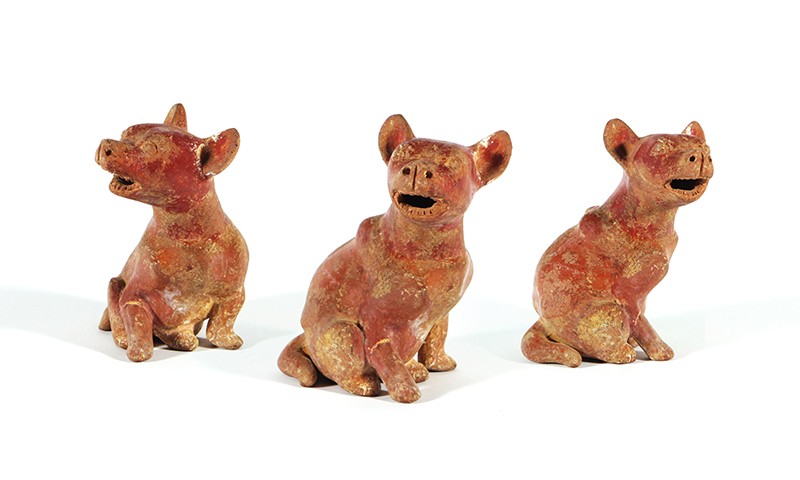 |
Sitting Dog, 200 BC-300 AD
Colima culture; Colima, Mexico
Clay and slip; 4 1/2 x 3 1/2 x 5 1/2 in.
99.82.8
Gift of John Ross, D.D.S. |
All Bite, No Bark
Dogs have remained versatile, benevolent additions to human society for as long as they have been domesticated. The same is very much true for the Xoloitzcuintli or Mexican Hairless, with the tragic corollary that during the Pre-Columbian Pre-Classic Era an indication of one’s taste in this breed of dog tended to be more of a culinary affair than an aesthetic one. Almost everything we know about the early cultures of the Western Mexican states of Colima, Jalisco, and Nayarit comes from their unique shaft tombs. Clay vessels and effigies found in these tombs speak volumes, and of all the figures found few were more prolific than the ceramic depictions of the Xoloitzcuintli.
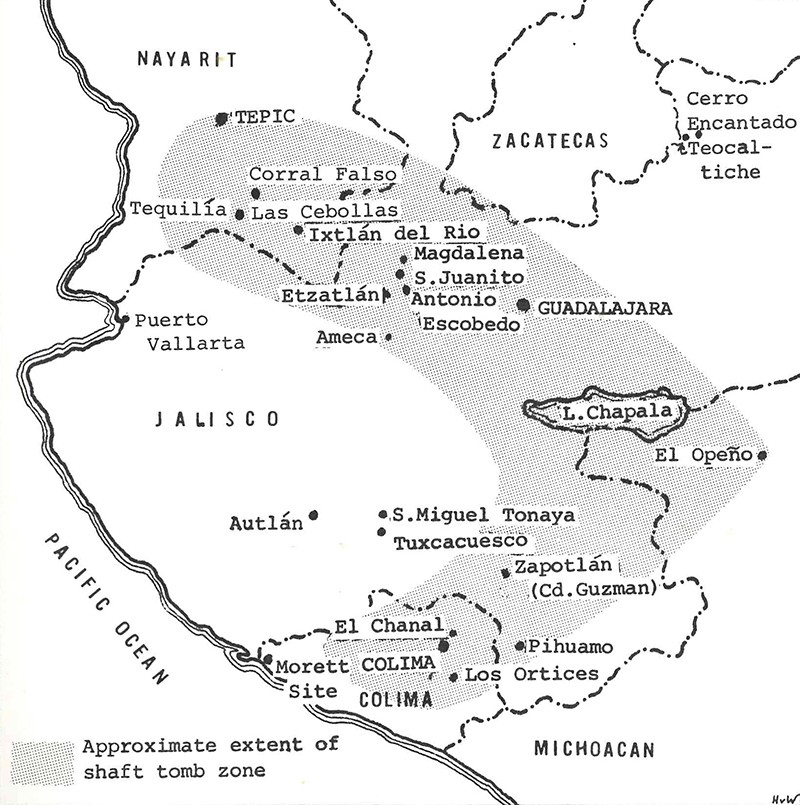 |
| Map of Western Mexico with the shaft tomb area highlighted. From The Shaft Tomb Figures of West Mexico by Hasso von Winning. |
The Tombs
The shaft tombs of Western Mexico were unique to the modern-day states of Colima, Jalisco, and Nayarit—even within the tri-state area, the tombs have only been found in the crescent-shaped band depicted above. The tombs were demarcated with a large circle of stones corresponding to their one and only shaft. These shafts, as deep as 60 ft., were filled with soil shortly after the burial. At the very bottom of this shaft, the tombs mostly had a single chamber, but sometimes featured a small complex of chambers. It was within these chambers that figures like the dog effigies featured in this post were discovered.
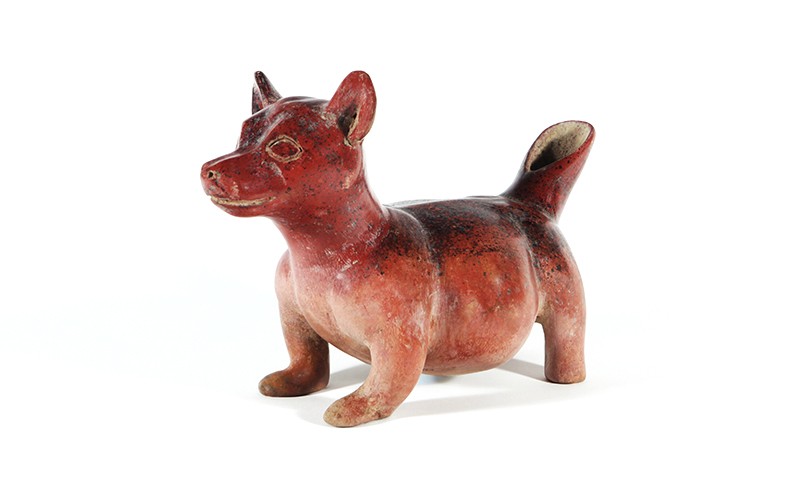 |
Effigy Vessel, c.200 B.C. - A.D. 300
Colima, West Mexico
Fired clay; 8 1/4 x 11 7/16 in.
F78.79.3
Anonymous Gift |
The Tri-State Area
The shaft tomb ceramics of Western Mexico are roughly split into three categories which were originally based on the three Mexican states they are found in: Colima, Jalisco, and Nayarit. The styles are very distinct from one another, as can be noted in their color, degree of polish, the features of the figures, and even the types of things depicted. Though the Colima style was the only one to feature multiple zoomorphic figures, all three do feature dog effigies. It is not coincidental, though, that the dog effigies featured in this post are all of the Colima style. Beginning in the state of Colima and travelling upwards to Nayarit, the aesthetics of dog pottery figures varies from whimsical, yet proportional to a high degree of abstraction—almost as if a game of telephone was played across the coincidentally telephone-shaped cartographic region in which they were made.

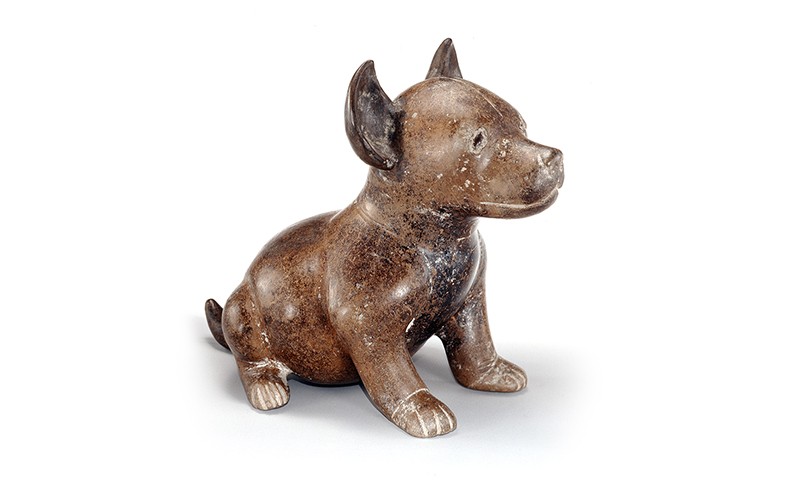 |
Seated Dog, c. 100 B.C.- 400 A.D.
West Mexico Shaft Tomb culture; Colima, West Mexico
Ceramic and paint; 11 1/8 x 9 x 12 in.
86.53.1
Gift of Sylvia Winstein |
Friends ‘til the End
Colima pottery figures tend to have either monochrome slips ranging in color from light orange to brownish black, the latter color generally being the result of black patination caused by firing, or bichrome tan and red slips as seen in the smallest effigy at the top of this post. The vessels were burnished before firing so the surface is highly polished, but evidence remains of individual burnishing strokes. Figures tend to be proportional but narrow slightly as they move away from the center of the figure. Even within the already narrowed range of Pre-Classic Colima dog effigies, they can be further subdivided based on whether they have a spout and, assuming they do, the location of their spout. The function of the spout, seen in two of this post’s effigies, was for the firing process—a requirement of larger, hollow vessels. The larger non-spouted vessel has a hole in its right ear from which it was fired. As far as experts can tell, there is no major importance in the differing poses of dogs, including the disembodied head, which was also seen with human figures.

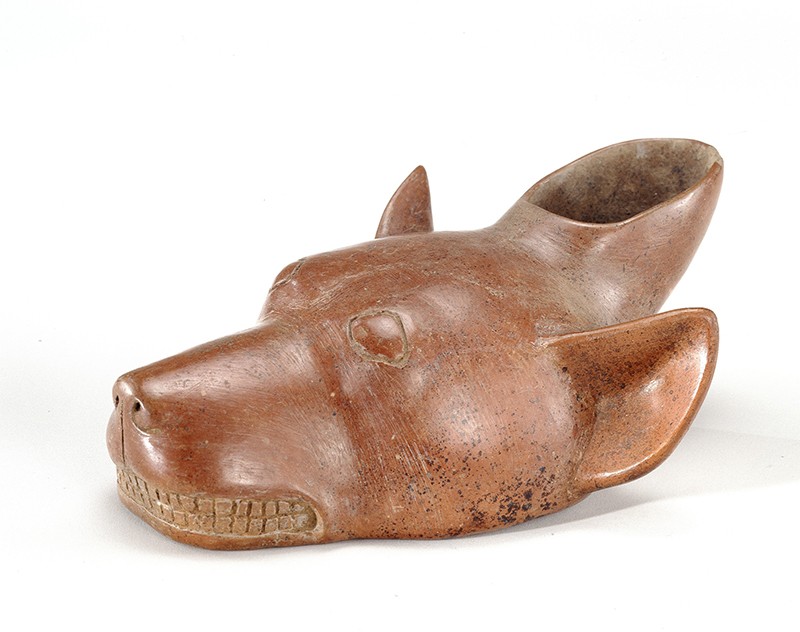 |
Spouted Vessel in the Form of a Dog Head, c. 200 B.C.- 300 A.D.
West Mexico Shaft Tomb culture; Colima, Mexico
Ceramic and paint; 4 x 7 1/4 x 10 in.
F79.80.2
Gift of Mr. Lee Perkal |
…And then Some
Archeologists have estimated that between 75 and 90 percent of all Colima shaft tombs contained dog effigies, making them among the most commonly created designs and by far the most popular zoomorphic effigies created by the Colima. The underlying rationale behind this is far more complex than the animals being man’s best friend. The earliest hypothesis was hinted at above. Aside from the misfortune of Xoloitzcuintli literally translating to “misshapen dog,” the Mexican Hairless was fattened, sold at market, and eaten in Pre-Columbian Mexico. There is evidence that the Pre-Classic inhabitants of Colima were buried with foodstuffs, but we do not see pottery representations of food outside of depictions of feasts in miniature. A far more likely impetus behind the sheer volume of dogs seen immortalized in ceramic lies in their mythological importance. Based on the most complex ceramic designs found, it is likely that by the 3rd Century BCE dogs already held the same mythological importance to the peoples of Western Mexico as they did in later Mesoamerican societies: bringers of lightning and guides to the underworld. The two may at first seem entirely disparate, but lightning was a primordial force for splitting open the earth where the underworld was found. The hope was almost certainly that these ceramic effigies would lead the dead to the afterlife.
Text and images may be under copyright. Please contact Collection Department for permission to use. References are available on request. Information subject to change upon further research.






Comments 1
eee